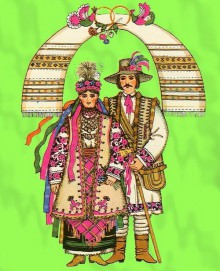The Bukovyna Regional Art Museum has for the first time not only let the general public see the traditional folk costume, but also focused on its indispensable attributes, such as woven waistbands, horbotka (women’s below-the-waist clothes), taistra (woven bags), and leather items – cheres (men’s belts), keptar, muntian (outerwear), and footwear (high boots, shoes, and postoly). The 60 exhibited items are locally made and represents almost all the regional districts. The museum staff either collected them in expeditions or acquired from private individuals. Today, residents of and visitors to Chernivtsi have a nice opportunity to see an original sleeveless blouse (tsurkanka, muntian) sewn from sheep’s fur and decorated with colored morocco patterns at the hem and margins, which both men and women wore.
The exhibit makes a lavish display of woven items because weaving was the most widespread home handicraft industry in Bukovyna. Women wove cloth from hemp and flax yarn. They made threads from wool and used them to weave carpets and cloth for sardak and manta (outerwear), etc. Waistband clothes are a local particularity of Bukovyna residents’ traditional folk apparel. There is a host of names by which these items, especially men’s waistbands, are called: kravka, baior, kinga, barvianka, cheres, and baiur okravka which men would put on over the shirt. Also particular in this Bukovyna line were broad woolen waistbands made of cold-shaded textiles. Like every ethnic region, Bukovyna had an ornament of its own. Polychromy was a characteristic feature of Bukovyna waistbands’ ornaments.
In general, the Bukovyna costume is distinguished for its material, cut, and decorations, and it shows a broad variety of both geometric and flower-based patterns. At the same time, it still preserves some signs of the Byzantine ornament. It is also adorned with patches embroidered in white satin stitch, fine cross-stitch, shtapovka, and twisted stitch. Also of wide use are beads, silk, wool, silver and golden threads, and metal tinsels. Embroidered articles show flowers of mixed red, yellow, and green color, with the red standing out. You can also see florid geometrical and flower-shaped compositions in woven bags called taistra…
The Art Museum exhibit will last until March 3.







